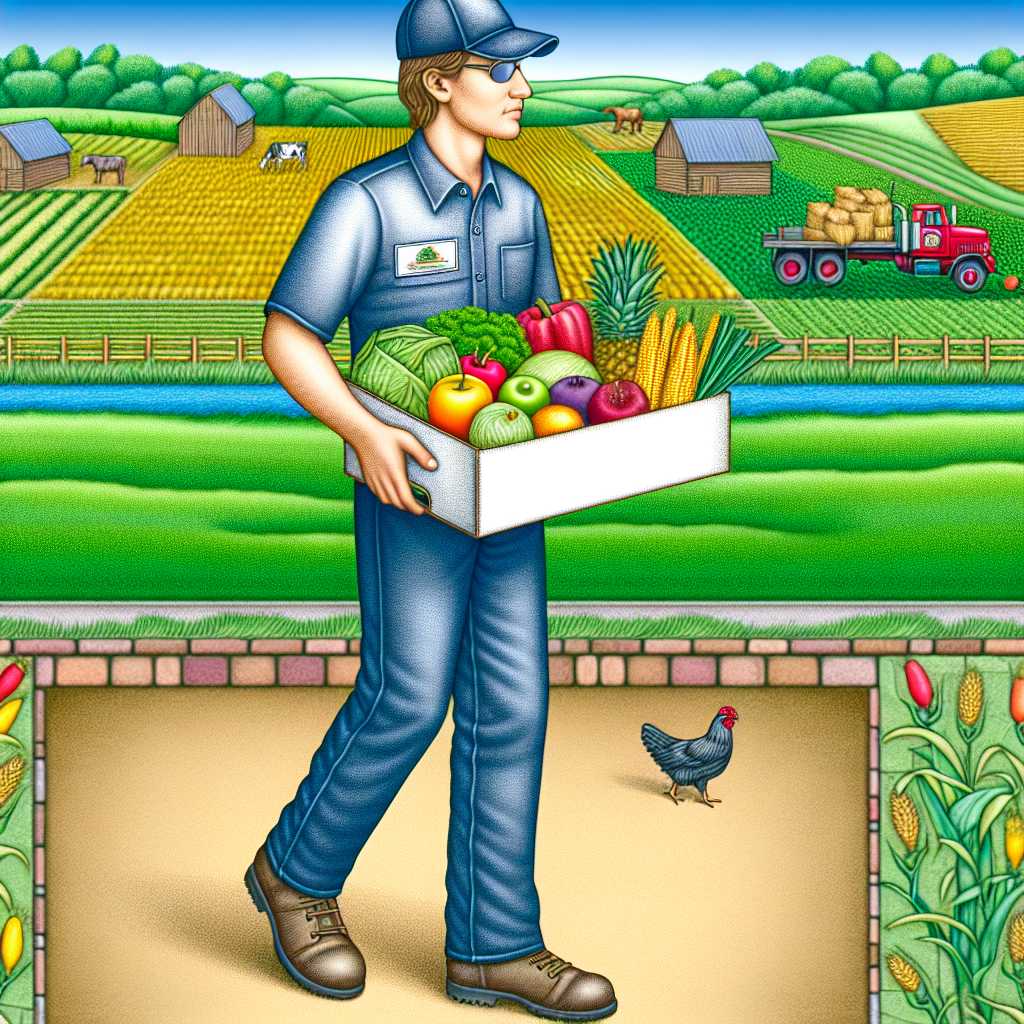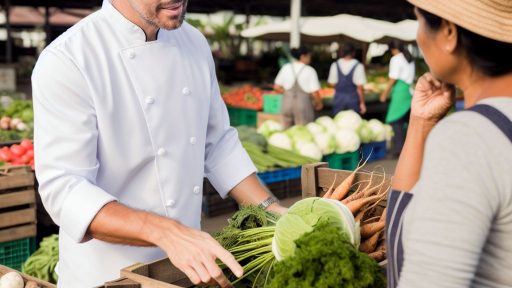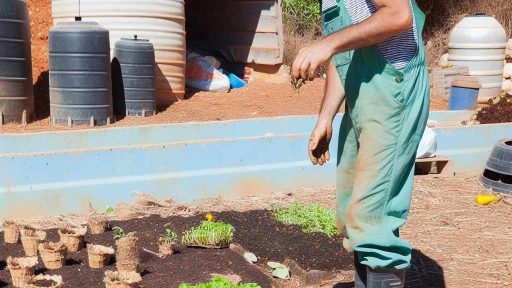Introduction to Community Supported Agriculture
Community Supported Agriculture, or CSA, connects local farms with consumers directly.
This system strengthens the relationship between farmers and their communities.
Members of a CSA typically purchase a share of the harvest at the beginning of the season.
In return, they receive fresh produce regularly throughout the growing season.
CSAs can vary in size and scope, allowing each farm to cater to their local community’s needs.
Benefits of Community Supported Agriculture
CSAs provide numerous benefits for both consumers and farmers.
First, consumers enjoy fresh, seasonal produce directly from local sources.
This practice helps reduce the carbon footprint associated with long-distance food transportation.
Additionally, CSA members often receive a diverse variety of vegetables and fruits.
Furthermore, supporting local farms strengthens the rural economy.
Engagement and Community Connection
CSAs foster a sense of community among members.
Members can participate in farm events such as harvest days and potlucks.
These activities offer opportunities for education about sustainable farming practices.
Moreover, individuals can learn about where their food comes from and how it’s grown.
This increased awareness can lead to healthier eating habits and greater food appreciation.
Transform Your Agribusiness
Unlock your farm's potential with expert advice tailored to your needs. Get actionable steps that drive real results.
Get StartedChallenges faced by CSA Farmers
While CSAs have many advantages, they also face their challenges.
Weather conditions can significantly impact crop yields and harvests.
Additionally, farmers often invest heavily upfront, which can be risky.
Moreover, the commitment of consumers for an entire season can be a hurdle.
Farmers must balance production with the demand of their members effectively.
Future of Community Supported Agriculture
The future looks promising for CSAs as consumer interest in local food grows.
More individuals seek sustainable and ethical food sources.
Leveraging technology can help improve communication and streamline operations.
Overall, CSAs can adapt and thrive in an evolving agricultural landscape.
Furthermore, they play a vital role in promoting environmentally-friendly practices.
Benefits of Farm Fresh Delivery Services for Local Communities
Support for Local Farmers
Farm fresh delivery services boost local economies.
By choosing these services, consumers support nearby farmers.
This choice helps to sustain family-owned farms.
Moreover, it encourages diverse agricultural practices.
Access to Fresh Produce
Delivery services provide easy access to fresh fruits and vegetables.
Consumers enjoy produce that is often harvested just hours before delivery.
This freshness enhances flavor and nutritional value.
Additionally, it reduces the reliance on processed foods.
Environmental Benefits
Farm fresh delivery reduces carbon footprints.
Minimal transportation means fewer emissions.
Locally sourced food requires less packaging as well.
Consequently, this practice supports sustainable farming methods.
Community Connections
These services strengthen bonds within local communities.
Consumers gain insights into where their food comes from.
Showcase Your Farming Business
Publish your professional farming services profile on our blog for a one-time fee of $200 and reach a dedicated audience of farmers and agribusiness owners.
Publish Your ProfileMoreover, they can connect with local farmers directly.
This fosters a sense of trust and collaboration.
Convenience for Consumers
Farm fresh delivery services offer unparalleled convenience.
People can order online from the comfort of their homes.
Delivery schedules can fit any lifestyle.
Furthermore, this service saves time for busy families.
Healthier Eating Habits
Access to fresh produce encourages healthier eating habits.
Families can incorporate more fruits and vegetables into meals.
This leads to better overall health and wellness.
Ultimately, fresh ingredients inspire cooking creativity.
How CSA Models Utilize Delivery Services
Definition of Community Supported Agriculture
Community Supported Agriculture connects consumers directly with local farmers.
Participants subscribe to receive fresh produce throughout the growing season.
This model strengthens local agricultural economies.
The Role of Delivery Services
Delivery services streamline the process of getting fresh food into consumers’ hands.
They ensure that produce arrives promptly and in excellent condition.
Furthermore, these services support the logistics of maintaining CSAs.
Enhancing Member Experience
Delivery services enhance the overall experience for CSA members.
Members enjoy the convenience of home delivery.
Additionally, delivery allows for greater flexibility in receiving their weekly shares.
Environmental Benefits
Utilizing local delivery services reduces carbon footprints.
Farmers can focus on sustainable practices while minimizing transportation needs.
Consequently, consumers receive fresher produce with less environmental impact.
Financial Considerations
Delivery services require financial planning for CSAs.
Some farms choose to include delivery costs in membership fees.
Others may partner with local businesses to keep expenses manageable.
Case Studies of Successful Delivery Systems
Many CSA programs successfully utilize delivery services.
Sunshine Farms delivered fresh produce weekly to over 200 members.
Green Grove CSA employs a bike delivery service to promote sustainability.
These models demonstrate effective logistics management within CSAs.
Gain More Insights: Farm Fresh Delivery Services for Locally Sourced Produce
Types of Produce Typically Offered Through Delivery Services
Seasonal Fruits
Farm fresh delivery services often include seasonal fruits.
These fruits vary based on the growing season.
Commonly offered fruits include apples, peaches, and strawberries.
Farmers harvest these fruits at their peak ripeness.
Vegetables
Many delivery services also provide a variety of vegetables.
Popular options include leafy greens, carrots, and tomatoes.
These vegetables are often picked just before delivery.
Herbs
Fresh herbs play a crucial role in farm fresh deliveries.
Common herbs include basil, cilantro, and parsley.
These herbs add flavor and nutrition to meals.
Showcase Your Farming Business
Publish your professional farming services profile on our blog for a one-time fee of $200 and reach a dedicated audience of farmers and agribusiness owners.
Publish Your ProfileOrganic Options
Organic produce is widely available through these services.
Farmers adhere to strict organic farming standards.
This ensures the absence of synthetic pesticides or fertilizers.
Specialty Items
Some services offer specialty or rare items.
These may include exotic fruits and heirloom varieties.
These items appeal to adventurous eaters and chefs.
Community Engagement
Delivery services often support local farmers and communities.
They create partnerships between consumers and producers.
Customers feel connected to their local agricultural systems.
Uncover the Details: From Crop Rotation To Artisan Bread: Connecting Sustainable Wheat Sources
Challenges Faced by Farm Fresh Delivery Services
Farm fresh delivery services encounter significant logistical challenges.
They must ensure timely delivery of perishable goods.
Additionally, coordinating pickups from farms can be complex.
Weather conditions often impact delivery schedules.
Furthermore, traffic disruptions can lead to delays.
Maintaining Quality and Freshness
Maintaining product quality is a key concern for delivery services.
Farmers need to find efficient ways to package produce.
This process prevents spoilage during transit.
Moreover, tracking freshness standards can be challenging.
Consumers expect top-notch quality with each order.
Building Customer Trust
Establishing customer trust requires consistent service.
New delivery services often struggle to gain recognition.
Building a loyal customer base takes time and effort.
Transparency in sourcing and delivery strengthens relationships.
Moreover, gathering and responding to feedback enhances trust.
Competition in the Market
The competition in the farm-fresh delivery market is strong.
Many new players constantly emerge, challenging existing businesses.
Providers must differentiate themselves through unique offerings.
Marketing strategies become crucial for visibility.
Additionally, pricing competitive rates is necessary to attract customers.
Sustainability Concerns
As awareness of sustainability grows, so do customer expectations.
Delivery services must adapt to eco-friendly practices.
This includes using sustainable packaging solutions.
Furthermore, reducing carbon footprints is increasingly important.
Sustainability initiatives can attract environmentally-conscious consumers.
Delve into the Subject: Artisanal Food Production for Home-Based Food Businesses
The Role of Technology in Managing CSA Deliveries
Enhancing Efficiency with Software Solutions
Technology streamlines the management of Community Supported Agriculture (CSA) deliveries.
Various software solutions help farmers track inventory and orders easily.
As a result, they can fulfill customer requests more efficiently.
Additionally, software can automate the scheduling of deliveries.
Showcase Your Farming Business
Publish your professional farming services profile on our blog for a one-time fee of $200 and reach a dedicated audience of farmers and agribusiness owners.
Publish Your ProfileThis automation saves time and reduces errors in logistics.
Improving Communication with Customers
Technology enhances communication between farmers and customers.
Farmers can use apps and platforms to inform members about delivery schedules.
Moreover, customers can provide feedback or adjust their orders in real-time.
This transparency builds trust and strengthens community relationships.
Utilizing Data Analytics for Better Planning
Data analytics plays a crucial role in optimizing CSA operations.
Farmers can analyze past delivery data to predict future trends.
By understanding demand patterns, they can plant accordingly.
This foresight minimizes food waste and maximizes sales potential.
Leveraging Online Platforms for Marketing
Online platforms offer farmers a way to reach a wider audience.
Through social media and dedicated websites, farmers can showcase their products.
Furthermore, these platforms facilitate pre-orders, enhancing cash flow.
Effective marketing strategies attract new members to CSA programs.
Integrating Delivery Management Systems
Delivery management systems simplify the logistics of CSA services.
These systems help in mapping routes for efficient delivery.
Moreover, they provide real-time tracking for both farmers and customers.
This integration enhances accountability and improves overall satisfaction.
Discover More: Permaculture Practices for Increasing Pollination and Plant Health

Sustainability and Environmental Impact of Farm Fresh Deliveries
Promoting Local Economies
Farm fresh delivery services strengthen local economies.
They connect consumers directly with local producers.
This reduces reliance on large-scale industrial agriculture.
As a result, communities benefit financially.
This model supports farmers in maintaining sustainable practices.
Reducing Carbon Footprint
Farm fresh deliveries contribute to a lower carbon footprint.
Transportation distances are often shorter compared to grocery store supply chains.
This approach minimizes greenhouse gas emissions significantly.
Moreover, local deliveries reduce the need for refrigeration during transport.
Encouraging Biodiversity
Community supported agriculture promotes biodiversity.
Farmers grow a variety of crops to meet consumer demands.
This diverse planting helps protect against pests and diseases.
Healthy ecosystems thrive through increased biodiversity.
Reducing Food Waste
Farm fresh delivery services help combat food waste.
They create a system that encourages planning and sharing of resources.
Consumers receive fresh produce tailored to their needs.
This reduces surplus that often goes unsold.
Educating the Community
Farm fresh programs educate communities about sustainable practices.
They raise awareness of the benefits of local food systems.
Workshops and events often accompany these deliveries.
Such initiatives foster a culture of sustainability among consumers.
Case Studies: Successful Farm Fresh Delivery Models
Agriculture Connection
Agriculture Connection is a community-supported agriculture program based in Oregon.
Showcase Your Farming Business
Publish your professional farming services profile on our blog for a one-time fee of $200 and reach a dedicated audience of farmers and agribusiness owners.
Publish Your ProfileIt connects local farms with consumers through home delivery services.
Customers select a subscription option that suits their needs.
This program promotes seasonal and organic produce.
Moreover, it builds relationships between farmers and consumers.
Farm to Fork Fresh
Farm to Fork Fresh serves urban areas across the Midwest.
Their model focuses on delivering locally sourced goods within 24 hours.
They partner with small-scale farms for fresh ingredients.
This strategy enhances food accessibility for urban families.
The program also includes educational materials about local agriculture.
HarvestMoon Delivery Service
HarvestMoon Delivery Service operates in the southeastern U.S.
They specialize in offering customized produce boxes.
Customers can choose from various items based on dietary preferences.
This flexibility encourages customer loyalty and repeat business.
Additionally, they offer recipes featuring seasonal produce.
Country Fresh Fare
Country Fresh Fare is a well-established CSA in the northeast.
They focus on sustainable practices while serving local communities.
This service promotes nutrition education alongside their delivery model.
Customers attend workshops on cooking and preserving food.
Consequently, this model fosters community engagement.
Green Farm Collective
Green Farm Collective emphasizes biodiversity in their deliveries.
They provide a wide variety of fruits and vegetables each week.
This promotes diverse diets for their customers.
Effective marketing strategies highlight the benefits of diversity.
Overall, they create a unique experience for each subscriber.
Future Trends in Farm Fresh Delivery Services for CSAs
Increased Demand for Local Produce
Consumers are gravitating toward local produce trends.
This shift promotes sustainability and reduces carbon footprints.
Additionally, customers enjoy fresher, healthier products.
Local farms, in turn, gain a loyal customer base.
Technology Integration for Efficiency
Technology will continue to revolutionize delivery services.
Farmers can use apps to streamline orders and deliveries.
This integration improves efficiency and customer satisfaction.
Moreover, real-time tracking enhances transparency in deliveries.
Expansion of Subscription Models
Subscription models for farm-fresh products show notable growth.
Consumers appreciate convenience and regularity in deliveries.
These models allow farmers to predict demand accurately.
Thus, they optimize their production levels accordingly.
Emphasis on Sustainability Practices
More consumers are prioritizing sustainability in their food choices.
CSA delivery services will adopt eco-friendly practices.
This includes using sustainable packaging materials.
In addition, reducing waste will become a top priority.
Showcase Your Farming Business
Publish your professional farming services profile on our blog for a one-time fee of $200 and reach a dedicated audience of farmers and agribusiness owners.
Publish Your ProfileCollaboration Among Local Farmers
Local farmers are increasingly collaborating with each other.
Collaborative efforts enhance product availability and variety.
These partnerships foster community resilience and support.
Ultimately, they enhance the CSA experience for consumers.
Focus on Nutritional Education
Delivery services will emphasize nutritional education for consumers.
Many consumers seek guidance on how to use their products.
Providing recipes and cooking tips will encourage engagement.
This enhances the overall value of CSA memberships.
Additional Resources
Farm to Table: Building Local and Regional Food Systems – SARE




